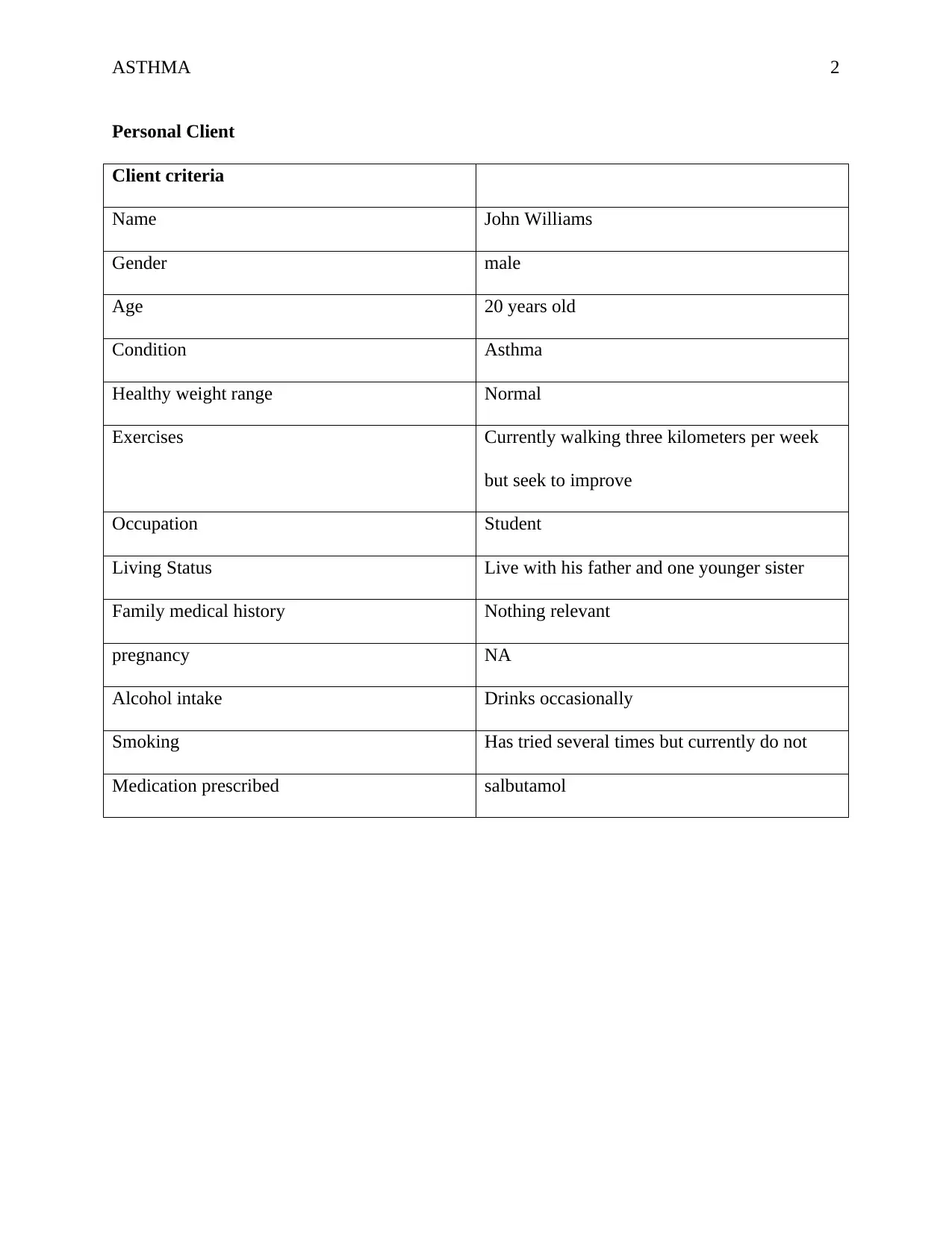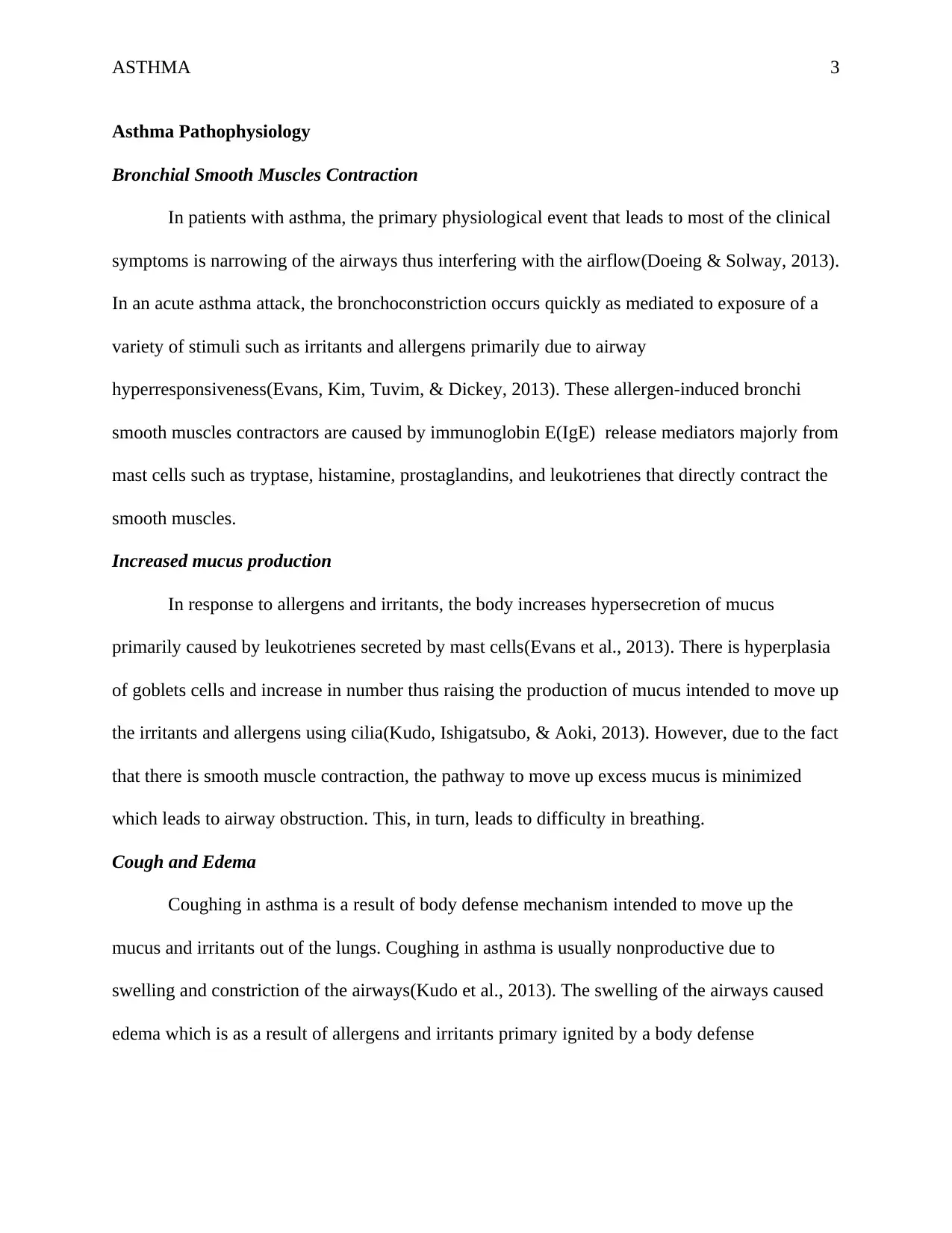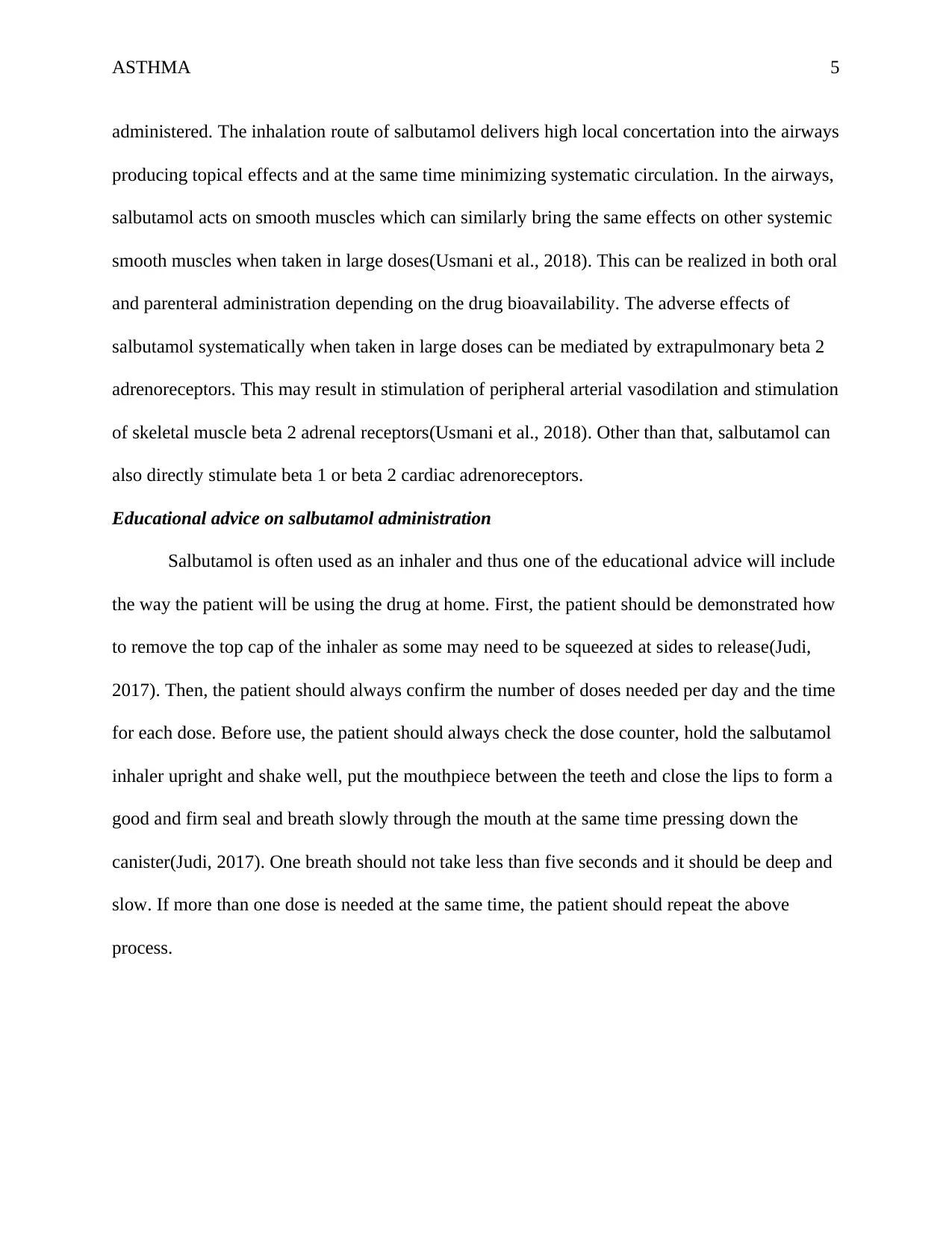Asthma Vodcast: A Case Study of Asthma Pathophysiology and Salbutamol
VerifiedAdded on 2022/11/25
|7
|1590
|178
Practical Assignment
AI Summary
This document presents a vodcast analysis of an asthma patient, John Williams, a 20-year-old student. It delves into the pathophysiology of asthma, focusing on bronchial smooth muscle contraction, increased mucus production, and the resulting cough and edema. The assignment explains the mechanism of action of salbutamol, a short-acting beta-2 adrenergic receptor agonist, including its topical and systemic effects. It also provides educational advice on the correct administration of salbutamol using an inhaler. An annotated bibliography is included, referencing peer-reviewed articles and government websites to support the information presented on asthma pathophysiology, pharmacology, and patient education. The case study aims to enhance understanding of asthma management and treatment.

Running head: ASTHMA 1
Asthma Vodcast Questions
(Author’s name)
(Institutional Affiliation)
Asthma Vodcast Questions
(Author’s name)
(Institutional Affiliation)
Paraphrase This Document
Need a fresh take? Get an instant paraphrase of this document with our AI Paraphraser

ASTHMA 2
Personal Client
Client criteria
Name John Williams
Gender male
Age 20 years old
Condition Asthma
Healthy weight range Normal
Exercises Currently walking three kilometers per week
but seek to improve
Occupation Student
Living Status Live with his father and one younger sister
Family medical history Nothing relevant
pregnancy NA
Alcohol intake Drinks occasionally
Smoking Has tried several times but currently do not
Medication prescribed salbutamol
Personal Client
Client criteria
Name John Williams
Gender male
Age 20 years old
Condition Asthma
Healthy weight range Normal
Exercises Currently walking three kilometers per week
but seek to improve
Occupation Student
Living Status Live with his father and one younger sister
Family medical history Nothing relevant
pregnancy NA
Alcohol intake Drinks occasionally
Smoking Has tried several times but currently do not
Medication prescribed salbutamol

ASTHMA 3
Asthma Pathophysiology
Bronchial Smooth Muscles Contraction
In patients with asthma, the primary physiological event that leads to most of the clinical
symptoms is narrowing of the airways thus interfering with the airflow(Doeing & Solway, 2013).
In an acute asthma attack, the bronchoconstriction occurs quickly as mediated to exposure of a
variety of stimuli such as irritants and allergens primarily due to airway
hyperresponsiveness(Evans, Kim, Tuvim, & Dickey, 2013). These allergen-induced bronchi
smooth muscles contractors are caused by immunoglobin E(IgE) release mediators majorly from
mast cells such as tryptase, histamine, prostaglandins, and leukotrienes that directly contract the
smooth muscles.
Increased mucus production
In response to allergens and irritants, the body increases hypersecretion of mucus
primarily caused by leukotrienes secreted by mast cells(Evans et al., 2013). There is hyperplasia
of goblets cells and increase in number thus raising the production of mucus intended to move up
the irritants and allergens using cilia(Kudo, Ishigatsubo, & Aoki, 2013). However, due to the fact
that there is smooth muscle contraction, the pathway to move up excess mucus is minimized
which leads to airway obstruction. This, in turn, leads to difficulty in breathing.
Cough and Edema
Coughing in asthma is a result of body defense mechanism intended to move up the
mucus and irritants out of the lungs. Coughing in asthma is usually nonproductive due to
swelling and constriction of the airways(Kudo et al., 2013). The swelling of the airways caused
edema which is as a result of allergens and irritants primary ignited by a body defense
Asthma Pathophysiology
Bronchial Smooth Muscles Contraction
In patients with asthma, the primary physiological event that leads to most of the clinical
symptoms is narrowing of the airways thus interfering with the airflow(Doeing & Solway, 2013).
In an acute asthma attack, the bronchoconstriction occurs quickly as mediated to exposure of a
variety of stimuli such as irritants and allergens primarily due to airway
hyperresponsiveness(Evans, Kim, Tuvim, & Dickey, 2013). These allergen-induced bronchi
smooth muscles contractors are caused by immunoglobin E(IgE) release mediators majorly from
mast cells such as tryptase, histamine, prostaglandins, and leukotrienes that directly contract the
smooth muscles.
Increased mucus production
In response to allergens and irritants, the body increases hypersecretion of mucus
primarily caused by leukotrienes secreted by mast cells(Evans et al., 2013). There is hyperplasia
of goblets cells and increase in number thus raising the production of mucus intended to move up
the irritants and allergens using cilia(Kudo, Ishigatsubo, & Aoki, 2013). However, due to the fact
that there is smooth muscle contraction, the pathway to move up excess mucus is minimized
which leads to airway obstruction. This, in turn, leads to difficulty in breathing.
Cough and Edema
Coughing in asthma is a result of body defense mechanism intended to move up the
mucus and irritants out of the lungs. Coughing in asthma is usually nonproductive due to
swelling and constriction of the airways(Kudo et al., 2013). The swelling of the airways caused
edema which is as a result of allergens and irritants primary ignited by a body defense
⊘ This is a preview!⊘
Do you want full access?
Subscribe today to unlock all pages.

Trusted by 1+ million students worldwide

ASTHMA 4
mechanism. Both the two symptoms are as a result of irritants, allergens and mucus production
thus the body responds for defense(Bonsignore et al., 2015).
Salbutamol mechanisms of action
Salbutamol can be an effective drug with a patient with asthma considering it is a
bronchial smooth muscle relaxant. Salbutamol is a short-acting selective beta 2 adrenergic
receptor agonist which consists of a mixture of both S and R isomers. S isomer is usually
associated with toxicity and has less affinity as compared to R isomer(Neininger et al., 2015).
After parenteral or oral administration, there is stimulation of both beta 1 and 2 receptors since
the sensitivity of beta 2 receptors are not absolute. The activation of beta 2 receptors on airway
muscles leads to an increase of cyclic 3,5 adenosine monophosphate (AMP) and activation of
adenyl cyclase. AMP increase leads to activation of protein kinases A resulting in relaxation as
intracellular calcium ions are lowered and phosphorylation of myosin is inhibited(Neininger et
al., 2015). All smooth muscles in the lungs are relaxed at this moment thus acting as an
antagonist of airway relaxation and preventing bronchoconstriction. Other than that, an increase
in AMP also inhibits mast cells mediators in the airways. After inhalation, these effects of
salbutamol are experienced within the first five to fifteen minutes at which the maximum
function can be experienced in the first one hour(Neininger et al., 2015).
Topical and systematic actions of salbutamol
Salbutamol acts on both beta 1 and 2 adrenoreceptors and thus it can have both topical
and systematic effects. Directly inhaled salbutamol after administration acts topically on bronchi
and bronchioles bring relaxation effects and thus allowing airflow(Usmani et al., 2018).
However, the effects of salbutamol can be experienced systematically depending on the dose
mechanism. Both the two symptoms are as a result of irritants, allergens and mucus production
thus the body responds for defense(Bonsignore et al., 2015).
Salbutamol mechanisms of action
Salbutamol can be an effective drug with a patient with asthma considering it is a
bronchial smooth muscle relaxant. Salbutamol is a short-acting selective beta 2 adrenergic
receptor agonist which consists of a mixture of both S and R isomers. S isomer is usually
associated with toxicity and has less affinity as compared to R isomer(Neininger et al., 2015).
After parenteral or oral administration, there is stimulation of both beta 1 and 2 receptors since
the sensitivity of beta 2 receptors are not absolute. The activation of beta 2 receptors on airway
muscles leads to an increase of cyclic 3,5 adenosine monophosphate (AMP) and activation of
adenyl cyclase. AMP increase leads to activation of protein kinases A resulting in relaxation as
intracellular calcium ions are lowered and phosphorylation of myosin is inhibited(Neininger et
al., 2015). All smooth muscles in the lungs are relaxed at this moment thus acting as an
antagonist of airway relaxation and preventing bronchoconstriction. Other than that, an increase
in AMP also inhibits mast cells mediators in the airways. After inhalation, these effects of
salbutamol are experienced within the first five to fifteen minutes at which the maximum
function can be experienced in the first one hour(Neininger et al., 2015).
Topical and systematic actions of salbutamol
Salbutamol acts on both beta 1 and 2 adrenoreceptors and thus it can have both topical
and systematic effects. Directly inhaled salbutamol after administration acts topically on bronchi
and bronchioles bring relaxation effects and thus allowing airflow(Usmani et al., 2018).
However, the effects of salbutamol can be experienced systematically depending on the dose
Paraphrase This Document
Need a fresh take? Get an instant paraphrase of this document with our AI Paraphraser

ASTHMA 5
administered. The inhalation route of salbutamol delivers high local concertation into the airways
producing topical effects and at the same time minimizing systematic circulation. In the airways,
salbutamol acts on smooth muscles which can similarly bring the same effects on other systemic
smooth muscles when taken in large doses(Usmani et al., 2018). This can be realized in both oral
and parenteral administration depending on the drug bioavailability. The adverse effects of
salbutamol systematically when taken in large doses can be mediated by extrapulmonary beta 2
adrenoreceptors. This may result in stimulation of peripheral arterial vasodilation and stimulation
of skeletal muscle beta 2 adrenal receptors(Usmani et al., 2018). Other than that, salbutamol can
also directly stimulate beta 1 or beta 2 cardiac adrenoreceptors.
Educational advice on salbutamol administration
Salbutamol is often used as an inhaler and thus one of the educational advice will include
the way the patient will be using the drug at home. First, the patient should be demonstrated how
to remove the top cap of the inhaler as some may need to be squeezed at sides to release(Judi,
2017). Then, the patient should always confirm the number of doses needed per day and the time
for each dose. Before use, the patient should always check the dose counter, hold the salbutamol
inhaler upright and shake well, put the mouthpiece between the teeth and close the lips to form a
good and firm seal and breath slowly through the mouth at the same time pressing down the
canister(Judi, 2017). One breath should not take less than five seconds and it should be deep and
slow. If more than one dose is needed at the same time, the patient should repeat the above
process.
administered. The inhalation route of salbutamol delivers high local concertation into the airways
producing topical effects and at the same time minimizing systematic circulation. In the airways,
salbutamol acts on smooth muscles which can similarly bring the same effects on other systemic
smooth muscles when taken in large doses(Usmani et al., 2018). This can be realized in both oral
and parenteral administration depending on the drug bioavailability. The adverse effects of
salbutamol systematically when taken in large doses can be mediated by extrapulmonary beta 2
adrenoreceptors. This may result in stimulation of peripheral arterial vasodilation and stimulation
of skeletal muscle beta 2 adrenal receptors(Usmani et al., 2018). Other than that, salbutamol can
also directly stimulate beta 1 or beta 2 cardiac adrenoreceptors.
Educational advice on salbutamol administration
Salbutamol is often used as an inhaler and thus one of the educational advice will include
the way the patient will be using the drug at home. First, the patient should be demonstrated how
to remove the top cap of the inhaler as some may need to be squeezed at sides to release(Judi,
2017). Then, the patient should always confirm the number of doses needed per day and the time
for each dose. Before use, the patient should always check the dose counter, hold the salbutamol
inhaler upright and shake well, put the mouthpiece between the teeth and close the lips to form a
good and firm seal and breath slowly through the mouth at the same time pressing down the
canister(Judi, 2017). One breath should not take less than five seconds and it should be deep and
slow. If more than one dose is needed at the same time, the patient should repeat the above
process.

ASTHMA 6
Annotated Bibliography
Bonsignore, M. R., Profita, M., Gagliardo, R., Riccobono, L., Chiappara, G., Pace, E., &
Gjomarkaj, M. (2015). Advances in asthma pathophysiology: stepping forward from the
Maurizio Vignola experience. European Respiratory Review : An Official Journal of the
European Respiratory Society, 24(135), 30–39. https://doi.org/10.1183/09059180.10011114
I used this article to examine the overall pathophysiology of asthma. It is current and peer
reviewed article and thus it provides reliable information.
Doeing, D. C., & Solway, J. (2013). Airway smooth muscle in the pathophysiology and
treatment of asthma. Journal of Applied Physiology (Bethesda, Md. : 1985), 114(7), 834–
843. https://doi.org/10.1152/japplphysiol.00950.2012
I used this article to examine the pathophysiology of asthma as related to contraction of smooth
muscles. The article is peer reviewed and thus provide reliable information.
Evans, C. M., Kim, K., Tuvim, M. J., & Dickey, B. F. (2013). Mucus hypersecretion in asthma:
causes and effects. Current Opinion in Pulmonary Medicine, 15(1), 4–11.
https://doi.org/10.1097/MCP.0b013e32831da8d3
I used this article to understand mucus hypersecretion in asthma pathophysiology. The article is
peer reviewed and thus provide reliable information.
Judi, W. (2017). How to use a Standard MDI (puffer) - National Asthma Council Australia.
Retrieved July 4, 2019, from https://www.nationalasthma.org.au/living-with-asthma/how-
to-videos/how-to-use-mdi
I used this website to check an educational advise on the use of a standard salbutamol puffer.
This is a govermnent website and thus it provide reliable information.
Kudo, M., Ishigatsubo, Y., & Aoki, I. (2013). Pathology of asthma. Frontiers in Microbiology, 4,
Annotated Bibliography
Bonsignore, M. R., Profita, M., Gagliardo, R., Riccobono, L., Chiappara, G., Pace, E., &
Gjomarkaj, M. (2015). Advances in asthma pathophysiology: stepping forward from the
Maurizio Vignola experience. European Respiratory Review : An Official Journal of the
European Respiratory Society, 24(135), 30–39. https://doi.org/10.1183/09059180.10011114
I used this article to examine the overall pathophysiology of asthma. It is current and peer
reviewed article and thus it provides reliable information.
Doeing, D. C., & Solway, J. (2013). Airway smooth muscle in the pathophysiology and
treatment of asthma. Journal of Applied Physiology (Bethesda, Md. : 1985), 114(7), 834–
843. https://doi.org/10.1152/japplphysiol.00950.2012
I used this article to examine the pathophysiology of asthma as related to contraction of smooth
muscles. The article is peer reviewed and thus provide reliable information.
Evans, C. M., Kim, K., Tuvim, M. J., & Dickey, B. F. (2013). Mucus hypersecretion in asthma:
causes and effects. Current Opinion in Pulmonary Medicine, 15(1), 4–11.
https://doi.org/10.1097/MCP.0b013e32831da8d3
I used this article to understand mucus hypersecretion in asthma pathophysiology. The article is
peer reviewed and thus provide reliable information.
Judi, W. (2017). How to use a Standard MDI (puffer) - National Asthma Council Australia.
Retrieved July 4, 2019, from https://www.nationalasthma.org.au/living-with-asthma/how-
to-videos/how-to-use-mdi
I used this website to check an educational advise on the use of a standard salbutamol puffer.
This is a govermnent website and thus it provide reliable information.
Kudo, M., Ishigatsubo, Y., & Aoki, I. (2013). Pathology of asthma. Frontiers in Microbiology, 4,
⊘ This is a preview!⊘
Do you want full access?
Subscribe today to unlock all pages.

Trusted by 1+ million students worldwide

ASTHMA 7
263. https://doi.org/10.3389/fmicb.2013.00263
I used this article to understand the general pathology of asthma. The article is peer reviewed and
thus provide reliable information.
Neininger, M. P., Kaune, A., Bertsche, A., Rink, J., Musiol, J., Frontini, R., … Bertsche, T.
(2015). How to improve prescription of inhaled salbutamol by providing standardized
feedback on administration: a controlled intervention pilot study with follow-up. BMC
Health Services Research, 15, 40. https://doi.org/10.1186/s12913-015-0702-x
I usedthis article to understand the mechanisms of action of salbutamol and its pharmacology.
This article is recent and peer reviewed thus it provide reliable information.
Usmani, O. S., Biddiscombe, M. F., Yang, S., Meah, S., Oballa, E., Simpson, J. K., … Maher, T.
M. (2018). The topical study of inhaled drug (salbutamol) delivery in idiopathic pulmonary
fibrosis. Respiratory Research, 19(1), 25. https://doi.org/10.1186/s12931-018-0732-0
I used this article to understand tropical and sytematic actions of salbutamol. This article is
recent and peer reviewed thus it provide reliable information.
263. https://doi.org/10.3389/fmicb.2013.00263
I used this article to understand the general pathology of asthma. The article is peer reviewed and
thus provide reliable information.
Neininger, M. P., Kaune, A., Bertsche, A., Rink, J., Musiol, J., Frontini, R., … Bertsche, T.
(2015). How to improve prescription of inhaled salbutamol by providing standardized
feedback on administration: a controlled intervention pilot study with follow-up. BMC
Health Services Research, 15, 40. https://doi.org/10.1186/s12913-015-0702-x
I usedthis article to understand the mechanisms of action of salbutamol and its pharmacology.
This article is recent and peer reviewed thus it provide reliable information.
Usmani, O. S., Biddiscombe, M. F., Yang, S., Meah, S., Oballa, E., Simpson, J. K., … Maher, T.
M. (2018). The topical study of inhaled drug (salbutamol) delivery in idiopathic pulmonary
fibrosis. Respiratory Research, 19(1), 25. https://doi.org/10.1186/s12931-018-0732-0
I used this article to understand tropical and sytematic actions of salbutamol. This article is
recent and peer reviewed thus it provide reliable information.
1 out of 7
Related Documents
Your All-in-One AI-Powered Toolkit for Academic Success.
+13062052269
info@desklib.com
Available 24*7 on WhatsApp / Email
![[object Object]](/_next/static/media/star-bottom.7253800d.svg)
Unlock your academic potential
Copyright © 2020–2025 A2Z Services. All Rights Reserved. Developed and managed by ZUCOL.





